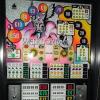Leaderboard
-
[[Template core/front/popular/memberRow is throwing an error. This theme may be out of date. Run the support tool in the AdminCP to restore the default theme.]]
[[Template core/front/popular/memberRow is throwing an error. This theme may be out of date. Run the support tool in the AdminCP to restore the default theme.]]
[[Template core/front/popular/memberRow is throwing an error. This theme may be out of date. Run the support tool in the AdminCP to restore the default theme.]]
[[Template core/front/popular/memberRow is throwing an error. This theme may be out of date. Run the support tool in the AdminCP to restore the default theme.]]
Popular Content
Showing content with the highest reputation on 11/06/21 in all areas
-
Welcome to the world of frustrating MPU3 faults. A few things you need to check, the 500HZ osc from the 555. Both the 10K timing and duty cycle resistors can go out of limits as can the big 0.1uF cap. Do IC9 and IC24 show any signs of the green plague on their legs, if so replace them (in sockets). The RAM sockets can be an issue as they are the 'stamped' type but due to the fact you have the daughterboard you can't fit the more reliable 'turned' ones. Sometimes contact cleaner will work but again any signs of the green stuff, whip em out! Don't forget to clean the legs of the daughterboard too and check the state of the actual RAM chip socket. The ROM cart socket can give you grief too if it's dirty or lost tension on the pins. A bit of contact cleaner and a very fine (and I mean 'very') emery board works wonders. Also if the little silver key spacer is broken (very common) the cart can just be out of alignment enough to stop it booting or at least become intermittent. See how you get on with that.....4 points
-
Many thanks for the pointers Bob. I have only previously ‘tickled’ the ROM socket connections with a fibre pencil and sprayed with contact cleaner so I will try your emery board suggestion. The key spacer appears to be ok on inspection. I don’t have access to a scope to measure the 555 so I will order a replacement 555, along with replacements for C33 and C34 which I also don’t have. What I can replace today is R67 - R69 and C32. The pins on IC9 & IC24 don’t have any green legs. I will give all the pins and all that area a good clean up anyway, and the same for the daughterboard. I do have replacements and turned pin sockets ready to fit for IC9 & IC24 so if there’s no improvement after replacing everything in the 555 circuit I will try that next. The only reason I haven’t done this already is that I’m unsure about soldering the turned pin sockets as I noticed a few of the pins also need soldering on top of the board. I will do a bit of research on that!2 points
-
I already have a couple of working mpu3 machines but no experience of fixing anything inside the metal box. I decided to have a go at building some experience so I’d have the confidence to try and fix any issues that might arise with my working machines. I purchased a non-working Royal Exchange and didn’t pay a lot for it but reasoned with myself that if my project failed then I could always sell it on or break it for spares. But I only want to preserve it and get it working!! I have no contacts to call on for help, but I’ve found this forum is a brilliant resource for people like myself who are willing to have a go. I’ve been logging everything I’ve done so the following posts detail my journey so far. The story so far part 1… Power on and Royal Exchange not working, only 2/3 flo tubes lit. I replaced the ST111 starters and all the flo tubes, then checked/replaced all the PSU fuses. The mpu3 board is a Mod 5 with a daughter board and 6117 RAM. No battery on the board but it was evident the old battery had leaked and done some damage as there is some masking missing. Someone has previously cleaned the board up, but upon first inspection I found quite a few green legged components, also T60 had a broken leg and C41 was missing. I replaced T60, T61, C41 and R92 – R95. I also cleaned between tracks with a fibre pencil and mopped up with IPA. Checking the white power plug I found that the 12v return pins 1 & 9 had burnt. I then fitted a bypass lead to 0v on the board as suggested elsewhere on this forum. I checked pin voltages on the white power plug and all OK. I fly wired a NiMh battery, confirmed 5v at the link and pin 24 on 6117 which dropped to 2.4v on power off. After cleaning all the plugs I connected the board and switched on… it booted but was stuck in reset. Reels stepped up & down and remained stiff, optos lit and display was now showing ‘Resetting RE 4.0’.1 point
-
When we live in a age where decals are so easily reproduced, why is their no dedicated sub for the uploading and downloading of them, I know with some machines reproduction isnt a option but for most 2 to 3 mins of scanning or photos could make a massive difference to a restored machine?1 point
-
The via's will take care of that! They are the rivets that join the top and bottom tracks together. You only need to solder from the bottom and capillary attraction will do the rest.1 point
-
All sorted.. amazing what you can achieve with a multi meter and a load of caps 😂. Thanks to all 😊1 point
-
1 point
-
1 point
-
No problem, It looks like they must have been past design and started manufacture of the MPU machines during the final days of advertising the electro's1 point
-
1 point
-
The story so far part 6… Previously when the machine was working and running in attract I had probed each pin of the 6117 RAM and IC9 & IC24. I had recorded what I found for each pin to keep for future reference. Probing these IC’s again now has thrown up the following differences… IC9 LS138 pin 6 and 6117 RAM pin 21 are now High (previously pulsing). I saw that IC9 pin 6 connects to the VMA line and the only other connection to this is IC1 pin 5 which was also high. I didn’t have a clue!! Before going off at a tangent I left everything for a week or so then re-read these notes. I’ve only had the garbled text on the display since changing R79 so I decided to remove and replace R79 again. There was some masking missing on the 0v track under where its sitting on top of the board, so I resolder making sure it’s away from that. Testing with white power/yellow/aux1 connected and I’ve now got ‘Resetting RE 4.0’ back. I probed the RAM IC’s again and all pins are back to when the machine was previously working and running in attract. I then connected up white power/yellow/aux1/red/red/green leads and back to just corrupt text on display but reels A & B step at power on then nothing. No optos lit but reels are stiff. I then removed R79 and T59 to enable a manual reset. Now with white power/yellow/aux1/red/red/green leads connected and power on gives all reels judder once moving slightly up or down. Reels are stiff but no optos lit. Display just shows garbled text. Manually jumping between 0v and ‘R’ causes all 4 reels to step up twice, then reels remain stiff with optos lit. Display is now showing ‘Resetting RE 4.0’. So I’m back to where I was before changing all the Auto Reset components… but now have to do a manual reset to achieve this. So that’s where I am today. Apologies for the lengthy posts. I’m trying but obviously lacking the technical knowledge needed so I would be grateful for any suggestions please for my next steps. Is there anything else I can measure/check to try and establish why it’s still stuck in reset? Cheers, Steve1 point
-
The story so far part 5… With just the white power plug connected I tested the following in the Auto Reset circuit… C36 10.23v across. I read elsewhere on this site that it needs to be 10.6v to release reset? R75 0v across R97 10.22v each side measured to 0v R77 15.88v and 10.22v measured to 0v D41 15.92v and 10.25v measured to 0v I replaced T57 – T59, D41 & D42, C36, and C40 (as noticed dry joint) I then connected up white power/yellow/aux1/red/red/green leads and nothing… just corrupt text on display. Unplugging red/red/green and try again I now get ‘Resetting RE 4.0’. Retesting Auto Reset circuit with just the white power plug connected… C36 now 10.84v R75 still 0v R97 now 10.86v each side R77 now 15.54v and 10.86v D41 now 15.46v and 10.87v I then replaced R79 as I haven’t done this previously, and also changed R90 (as noticed it was corroded). Testing with just white power/yellow/aux1 connected and I’ve now just got garbled text on the display. Frustrating as it feels like I’m going backwards!!1 point
-
The story so far part 4… I checked for 5v at green plug pins 6, 7, 8, 9 and no 5v at pin 6. Looking at RP8 there was 5v at pin 4 but not at pin 13. Also no 5v at IC17 pin 15. I replaced RP8 and T55 BCX38C and no change but now I’ve got 5v at green plug pin 6 but no 5v at pin 8. I then replaced IC17 LS138 & C41 (next to IC5) as I noticed it was damaged. Test and back to no 5v at pin 6 but 5v is back at pin 8. I replaced IC5 6821 and still no 5v at green plug pin6/IC17 pin 5/RP8 pin 13. I’m now getting ‘Resetting RE 4.0’ with white power/yellow/aux1/red/red/green leads connected but it’s still stuck in reset. Reels step up & down on power on but don’t spin. I have no idea if the reel issue is fixed, maybe the no 5v at one of the pins is supposed to happen? I started thinking that currently being stuck in reset may be unconnected to the green plug, and I have a separate issue somewhere within the Auto Reset circuit?1 point
-
The story so far part 3… After some more research on here I decided to change the Reel C driver transistors T47 – T50 BCX38C, and I checked OK for 330R across the pins on RP7. I also changed the old looking C1 – C3 regulator board capacitors whilst the board was out. I then just connected the board up with the white power plug and confirmed the regulator board voltages and the board 5v link and D44/D45 voltages, all OK. I then connected up white power/yellow/aux1/red/red/green leads and no boot… just ‘CCCCCC’ on display. Removing red/red/green gave me ‘Resetting RE 4.0’ but stuck in reset. Replacing red/red gave me the same but with green connected I got either ‘CCCCCC’ or other garbled characters on the display. It was at this point I believe I started getting lost because I decided to look closer at the green plug and work backwards.1 point
-
The story so far part 2… I replaced further corroded components R84, R85, R87, R97. Changed D44 & D45 for P600B. Further cleaned between tracks and around soldered plugs. Continuity checked all plugs. All plugs then sprayed with contact cleaner, reconnected board and switched on… now resets and goes into attract. Machine plays, but no sound, and meters working intermittently. Tested speaker in another mpu3 and working OK so I replaced T11 and R33 and sound now working. For a couple of weeks I was playing the machine daily and would leave it in attract for at least 4 hours. I then started to get an issue with the machine resetting itself randomly when in attract or being played. After doing some research on this forum I decided to focus on the Auto Reset circuit. I replaced T57 – T59, C46, R75 – R78, R80 – R82, and removed T56 & T62 to disable the Anti-Spark circuit. I refitted board and now all working OK and no more random resetting. All fine for a couple of weeks until I started getting reel judder and independent movement on Reel C. This was happening when warmed up say about 25 plays after switch on, and would do it in attract or whilst playing… sometimes it would eventually give a Reel C Alarm.1 point
-
1 point
-
I think Fore and Aft did have a lighthouse on the glass, but just standard symbols on the reels IIRC.1 point
-
1 point
-
An interesting point of which only the present or new owner will be able to accurately answer and possibly the reason the machine has been spared of being converted to all cash. As it was originally manufacture as a 50p token max payout machine, JPM will have fitted only a 5 pulse payout cam as it pays 10p tokens as well as 10p cash. For this later £1 token model it would need a 10 pulse cam OR the easy option was to fit a 2x10p token payslide which is my thoughts. If this is the setting then the same original 5 pulse cam could be left as is and for the £1 tokens 5 pulses of a 2x token slide is all that's needed. As the 10p slide is only a single 1x 10p slide, wiring the token payout slide over to the cash payout slide is not an option and the £1 would only payout 50p cash. Just dragged my Housey Housey schematic out to see which version it is and it's the modified £1 drawing so, I can confirm it is indeed fitted with a 2x 10p token payslide.1 point
-
1 point
-
I think it's not used much as machines swap hands without the need to advertise.like people queuing waiting for a member to release one.i usually advertise here as most sites like Ebay are full of idiots.plusvit helps others and keeps in colle tors circle.1 point





